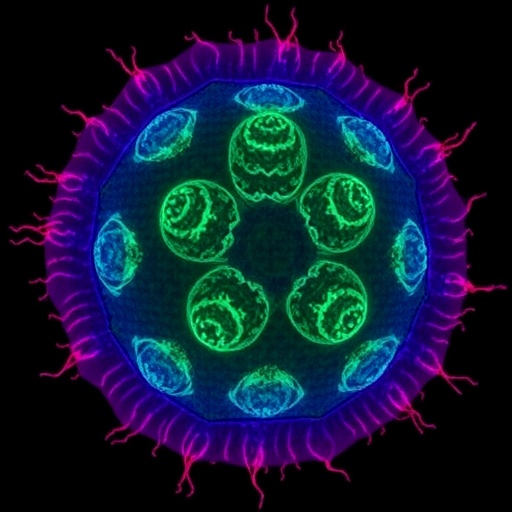In an exciting advancement in reproductive biology, researchers have unveiled crucial insights regarding the role of circular RNAs, specifically Circ_0008440, in modulating trophoblast cell behavior. Trophoblast cells play a fundamental role during pregnancy, facilitating the implantation of the embryo and establishing connections with maternal tissues. The regulation of these cells is pivotal for a successful pregnancy, and any dysregulation can lead to severe complications. This makes understanding their underlying mechanisms vital for both reproductive health and therapeutic interventions.
The study, conducted by an adept team of scientists, emphasizes the significance of the Circ_0008440 molecule. This circular RNA exhibits the capability to modify cellular processes, particularly those governing cell proliferation and apoptosis—the programmed cell death crucial for removing unhealthy or unnecessary cells. By focusing on Circ_0008440, the researchers aim to decipher how this RNA influences trophoblast survival and proliferation, which could have substantial implications for pregnancy outcomes.
Through their meticulous experiments, the researchers have illustrated that Circ_0008440 acts as a tumor suppressor in trophoblast cells. The findings suggest that when Circ_0008440 is inhibited, there is an observable increase in cell proliferation accompanied by a decrease in apoptosis. This phenomena highlights the importance of maintaining adequate levels of Circ_0008440 to ensure healthy trophoblast function and, by extension, a successful pregnancy.
An essential aspect of this study is the exploration of the miR-942-5p/PFKFB2 signaling pathway, which is critically involved in mediating the effects of Circ_0008440. miR-942-5p is a microRNA that has been linked to various cellular processes, and its interaction with PFKFB2—an enzyme instrumental in the regulation of glucose metabolism—provides insights into how trophoblast cells can manage their energy resources during periods of rapid growth and differentiation.
The researchers identified that Circ_0008440 inhibits the expression of miR-942-5p, thereby removing its repressive effect on PFKFB2. The balance between these elements suggests a finely tuned regulatory mechanism that ensures trophoblast cells can adapt to the metabolic demands of pregnancy. This understanding may lead to the development of novel therapeutic strategies aimed at enhancing trophoblast function in cases where cell proliferation is compromised, such as in placental disorders.
The implications of such research extend into the realm of clinical applications. By uncovering the molecular interactions that underpin trophoblast biology, therapeutic approaches could be designed for conditions like preeclampsia or placental insufficiencies. In these scenarios, the restoration of normal Circ_0008440 levels or the modulation of linked pathways might be a potential strategy to improve outcomes for both mother and fetus.
Furthermore, the findings highlight the broader significance of non-coding RNAs in cellular regulation. CircRNAs have garnered increasing attention in recent years due to their stability and potential as biomarkers or therapeutic targets. Circ_0008440 serves as a case study exemplifying how investigating these molecules can uncover new layers of complexity within cellular processes, proving essential for advancing our comprehension of biological regulation.
As part of the ongoing discourse regarding reproductive health, the results of this study prompt further investigation. Future studies will be necessary to validate these findings in vivo, exploring how these interactions play out in a living organism compared to cell cultures. This leap from bench to bedside could ultimately delineate novel approaches for diagnosing and managing pregnancy-related complications, breathing new hope into reproductive medicine.
The implications for prevention strategies are equally compelling. Understanding the precise roles of Circ_0008440 and its associated pathways may allow clinicians to identify at-risk individuals through genetic screening or to devise lifestyle interventions that foster a conducive environment for healthy pregnancies. Early intervention, tailored to modulate the activity of critical RNA elements, could fundamentally alter trajectories in reproductive health.
Moreover, this research underscores the importance of interdisciplinary collaboration in unlocking complex biological questions. The amalgamation of molecular biology, genetics, and clinical expertise drove the team’s success in unraveling the intricate web of interactions governing trophoblast cell function. Such collaborations are vital as scientists strive to translate fundamental discoveries into clinically relevant solutions.
As we look towards the future, the potential for leveraging Circ_0008440 in therapeutic contexts is expansive. Innovations in gene editing technologies like CRISPR/Cas9 may offer a pathway to manipulate this circular RNA effectively. Further exploration could lead to groundbreaking therapies that directly address the cellular dysfunctions observed in problematic pregnancies.
In conclusion, the research surrounding Circ_0008440 and its role in trophoblast cell behavior not only enhances our fundamental understanding of reproductive biology but also potentiates exciting future directions for clinical intervention. As scientists continue to uncover the complexities of cellular communication and regulation, the hope is to foster improved reproductive health for generations to come.
This investigation, crucially emphasizing the intersecting roles of cellular signaling and RNA biology, marks a significant contribution to the field of reproductive sciences. The implications of such findings are destined to ripple through both the scientific community and clinical practices, ultimately fostering a deeper understanding of how micro-level cellular events influence macro-level outcomes in human health.
Understanding Circ_0008440’s regulatory mechanisms could serve as a beacon for future research endeavors in reproductive health. The transformations in our comprehension of trophoblast cell dynamics could one day lead to novel preventative measures that prioritize maternal and fetal well-being.
Subject of Research: The role of Circ_0008440 in trophoblast cell proliferation and apoptosis.
Article Title: Correction: Circ_0008440 Inhibits Proliferation and Promotes Apoptosis of Trophoblast Cells through the miR-942-5p/PFKFB2 Axis.
Article References:
Guo, L., Ji, T., Xu, X. et al. Correction: Circ_0008440 Inhibits Proliferation and Promotes Apoptosis of Trophoblast Cells through the miR-942-5p/PFKFB2 Axis.
Reprod. Sci. (2025). https://doi.org/10.1007/s43032-025-01996-3
Image Credits: AI Generated
DOI:
Keywords: Circular RNA, trophoblast cells, apoptosis, miR-942-5p, PFKFB2, reproductive health.




